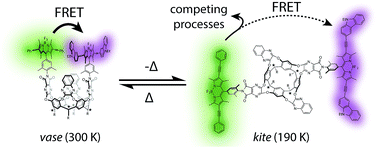当前位置:
X-MOL 学术
›
Chem. Sci.
›
论文详情
Our official English website, www.x-mol.net, welcomes your feedback! (Note: you will need to create a separate account there.)
Disentanglement of excited-state dynamics with implications for FRET measurements: two-dimensional electronic spectroscopy of a BODIPY-functionalized cavitand†
Chemical Science ( IF 8.4 ) Pub Date : 2018-03-15 00:00:00 , DOI: 10.1039/c8sc00818c John P. Otto 1, 2, 3, 4 , Lili Wang 1, 2, 3, 4 , Igor Pochorovski 4, 5, 6, 7 , Samuel M. Blau 4, 8, 9, 10 , Alán Aspuru-Guzik 4, 8, 9, 10, 11 , Zhenan Bao 4, 5, 6, 7 , Gregory S. Engel 1, 2, 3, 4 , Melanie Chiu 4, 5, 6, 7
Chemical Science ( IF 8.4 ) Pub Date : 2018-03-15 00:00:00 , DOI: 10.1039/c8sc00818c John P. Otto 1, 2, 3, 4 , Lili Wang 1, 2, 3, 4 , Igor Pochorovski 4, 5, 6, 7 , Samuel M. Blau 4, 8, 9, 10 , Alán Aspuru-Guzik 4, 8, 9, 10, 11 , Zhenan Bao 4, 5, 6, 7 , Gregory S. Engel 1, 2, 3, 4 , Melanie Chiu 4, 5, 6, 7
Affiliation

|
Förster Resonance Energy Transfer (FRET) is the incoherent transfer of an electronic excitation from a donor fluorophore to a nearby acceptor. FRET has been applied as a probe of local chromophore environments and distances on the nanoscale by extrapolating transfer efficiencies from standard experimental parameters, such as fluorescence intensities or lifetimes. Competition from nonradiative relaxation processes is often assumed to be constant in these extrapolations, but in actuality, this competition depends on the donor and acceptor environments and can, therefore, be affected by conformational changes. To study the effects of nonradiative relaxation on FRET dynamics, we perform two-dimensional electronic spectroscopy (2DES) on a pair of azaboraindacene (BODIPY) dyes, attached to opposite arms of a resorcin[4]arene cavitand. Temperature-induced switching between two equilibrium conformations, vase at 294 K to kite at 193 K, increases the donor–acceptor distance from 0.5 nm to 3 nm, affecting both FRET efficiency and nonradiative relaxation. By disentangling different dynamics based on lifetimes extracted from a series of 2D spectra, we independently observe nonradiative relaxation, FRET, and residual fluorescence from the donor in both vase to kite conformations. We observe changes in both FRET rate and nonradiative relaxation when the molecule switches from vase to kite, and measure a significantly greater difference in transfer efficiency between conformations than would be determined by standard lifetime-based measurements. These observations show that changes in competing nonradiative processes must be taken into account when highly accurate measurements of FRET efficiency are desired.
中文翻译:

激发态动力学的解开对FRET测量的影响:BODIPY功能化的空泡石的二维电子光谱†
福斯特共振能量转移(FRET)是电子激发从供体荧光团到附近受体的非相干转移。通过从标准实验参数(例如荧光强度或寿命)推断转移效率,FRET已被用作纳米级局部发色团环境和距离的探针。在这些推论中,通常假定来自非辐射弛豫过程的竞争是恒定的,但实际上,这种竞争取决于供体和受体的环境,因此可能会受到构象变化的影响。为了研究非辐射弛豫对FRET动力学的影响,我们对附在间苯二酚[4] arene cavitand的相对臂上的一对氮杂硼烷(BODIPY)染料进行了二维电子光谱(2DES)。花瓶在294 K到风筝在193 K,将供体-受体的距离从0.5 nm增加到3 nm,从而影响FRET效率和非辐射弛豫。通过基于从一系列2D光谱中提取的生命周期解开不同的动力学,我们独立观察了两个花瓶到风筝构象中来自供体的非辐射弛豫,FRET和残留荧光。当分子从花瓶变成风筝时,我们观察到FRET速率和非辐射弛豫的变化,与构架之间基于寿命的标准测量相比,构象之间的传输效率差异要大得多。这些观察结果表明,当需要高精度的FRET效率测量时,必须考虑竞争性非辐射过程的变化。
更新日期:2018-03-15
中文翻译:

激发态动力学的解开对FRET测量的影响:BODIPY功能化的空泡石的二维电子光谱†
福斯特共振能量转移(FRET)是电子激发从供体荧光团到附近受体的非相干转移。通过从标准实验参数(例如荧光强度或寿命)推断转移效率,FRET已被用作纳米级局部发色团环境和距离的探针。在这些推论中,通常假定来自非辐射弛豫过程的竞争是恒定的,但实际上,这种竞争取决于供体和受体的环境,因此可能会受到构象变化的影响。为了研究非辐射弛豫对FRET动力学的影响,我们对附在间苯二酚[4] arene cavitand的相对臂上的一对氮杂硼烷(BODIPY)染料进行了二维电子光谱(2DES)。花瓶在294 K到风筝在193 K,将供体-受体的距离从0.5 nm增加到3 nm,从而影响FRET效率和非辐射弛豫。通过基于从一系列2D光谱中提取的生命周期解开不同的动力学,我们独立观察了两个花瓶到风筝构象中来自供体的非辐射弛豫,FRET和残留荧光。当分子从花瓶变成风筝时,我们观察到FRET速率和非辐射弛豫的变化,与构架之间基于寿命的标准测量相比,构象之间的传输效率差异要大得多。这些观察结果表明,当需要高精度的FRET效率测量时,必须考虑竞争性非辐射过程的变化。



























 京公网安备 11010802027423号
京公网安备 11010802027423号